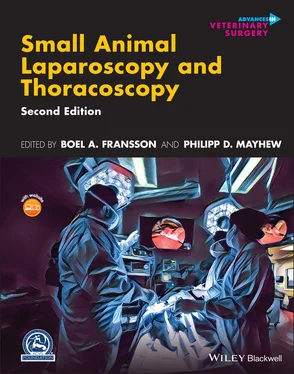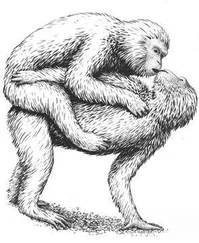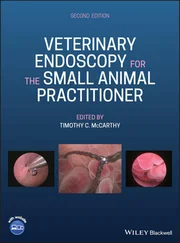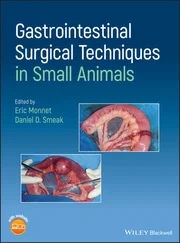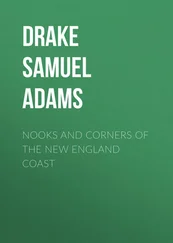16 Section V: Fundamental Techniques in Thoracoscopy 27 Anesthesia for Thoracoscopy Pathophysiology of One‐Lung Anesthesia Anesthesia One‐Lung Ventilation Pain Management References 28 Patient Positioning, Port Placement, and Access Techniques for Thoracoscopic Surgery Operating Room Patient Positioning Thoracic Access Techniques Thoracic Port Types, Placement, and Position Placement of Instrument Portals Complications of Thoracic Access References 29 Thoracoscopic Anatomy, Exploration, and Diagnostic Thoracoscopy Preoperative Considerations Patient Preparation Surgical Technique Surgical Technique Complications and Prognosis References 30 Thoracoscopic Contraindications, Complications, and Conversion Strategies to Avoid Complications Complications Postoperative Surveillance References
17 Section VI: Thoracoscopic Surgical Procedures 31 Thoracoscopic and Thoracoscopic‐Assisted Lung Biopsy and Lung Lobectomy Preoperative Considerations Patient Evaluation and Preparation Surgical Techniques Postoperative Care References 32 Thoracoscopic Pericardial Window and Subtotal Pericardectomy in Dogs and Cats Preoperative Considerations Patient Preparation Surgical Technique Complications and Prognosis Postoperative Care References 33 Thoracoscopic Placement of Epicardial Pacemakers Preoperative Considerations Surgical Approach Patient Preparation Surgical Technique Complications and Prognosis Postoperative Care References 34 Right Auricular Mass Resection Relevant Pathophysiology Diagnostic Workup and Imaging Patient Selection Required Instrumentation Surgical Technique Challenges Specific to the Technique Complications and Prognosis Postoperative Care References 35 Minimally Invasive Treatment of Chylothorax Preoperative Considerations; Etiology of Disease Treatment of Chylothorax Surgical Management Patient Preparation Surgical Techniques Surgical Techniques Intraoperative Lymphangiography Postoperative Care Complications Conclusion References 36 Thoracoscopic Treatment of Vascular Ring Anomalies Preoperative Considerations Patient Evaluation and Preparation Surgical Technique Intraoperative Complications Conversion Postoperative Care References 37 Thoracoscopic Mediastinal Mass Resection Preoperative Considerations Patient Preparation Surgical Technique Postoperative Care, Complications, and Prognosis References 38 Minimally Invasive Cancer Staging in the Thorax Diagnostic Thoracoscopy and Biopsy Lymphatic Staging Preoperative Considerations Patient Preparation Surgical Technique Complications and Challenges Postoperative Care References
18 Section VII: Surgery facilitated by Exoscopy 39 Exoscopy in Small Animal Surgery: General Utilization and Pituitary Surgery Exoscopy Use in General Small Animal Surgery What Is Exoscopy? Advantages and Disadvantages Equipment Necessary for Exoscopy Uses of Exoscopy Use of Exoscopy in Small Animal Head and Neck Surgery Use of Exoscopy in Abdominal and Urogenital Surgery Use of Exoscopy in Exotic Animal Medicine Use of Exoscopy in Neurosurgery Exoscopy Highlight: Pituitary Surgery Preoperative Considerations Patient Preparation Surgical Technique Complications and Prognosis References
19 Index
20 End User License Agreement
1 Chapter 2 Table 2.1 Features of currently available barbed suture.
2 Chapter 3 Table 3.1 Image troubleshooting guide. Table 3.2 Matching diameter of telescope and light cable for optimal illumi...
3 Chapter 5 Table 5.1 Tissue effect in relation to temperature. Table 5.2 Various energy devices and their capabilities. Table 5.3 Internal stapling heights for medtronic Tri‐Staple technology for...
4 Chapter 6 Table 6.1 Acronyms used in text. Table 6.2 Examples of procedures that have been adopted with single‐port, s...
5 Chapter 22Table 22.1 Considerations to discuss with a client who requests hormone spa...
6 Chapter 23Table 23.1 Considerations to discuss with the dog's owner when deciding for...
7 Chapter 27Table 27.1 Effect of different factors on hypoxic pulmonary vasoconstrictio...Table 27.2 Tracheal and bronchial dimensions in dogs. aTable 27.3 Comparison of Univent tubes with regular endotracheal tubes.Table 27.4 Details of left double‐lumen tubes.
8 Chapter 35Table 35.1 Endoscopic instruments and devices used for chylothorax procedur...
9 Chapter 36Table 36.1 Instruments required for thoracoscopy for vascular ring anomaly.
1 f10 Figure 1 Bozzini’s Lichtleiter, a vase‐shaped, leather‐covered tin lantern u... Figure 2 Laparoscopy performed in 1974, before the introduction of video lap... Figure 3 From left to right, Drs. Todd Tams, Steve Hill, and David Twedt are... Figure 4 A proctoscope is used as a low‐cost laparoscope for visualization o... Figure 5 A Corkmaster, a carbon dioxide dispenser intended for opening wine ... Figure 6 Drs. Lynnetta J. Freeman and Ronald J. Kolata are performing laparo... Figure 7 Dr. Clarence Rawlings. Figure 8 The Veterinary Endoscopy Society was founded by Dr. Eric Monnet in ...
2 Chapter 1 Figure 1.1 A number of laparoscopic skills training boxes are commercially a... Figure 1.2 Commonly used dimensions in laparoscopic training boxes. Figure 1.3 An example of a homemade training box. Figure 1.4 High‐quality web cameras enable real‐time imaging to a relatively... Figure 1.5 Logotype for the Veterinary Assessment of Laparoscopic Skills (VA... Figure 1.6 Peg transfer task. Six objects are lifted from the left‐sided peg... Figure 1.7 Pattern cut task. A 4‐cm circle is cut, with a penalty applied if... Figure 1.8 Ligature loop application task. Figure 1.9 Extracorporeal suture task. (A). A suture is placed in a Penrose ... Figure 1.10 Intracorporeal suture task. Figure 1.11 The LapSimHaptic system virtual reality trainer is combining hig... Figure 1.12 The ProMis augmented reality trainer is a combination of a physi... Figure 1.13 Graphic representation of an ideal training program, balanced wi...
3 Chapter 2 Figure 2.1 Pistol grip laparoscopic needle driver. Figure 2.2 Needle driver with handle designed for thumb–ring finger grip. Th... Figure 2.3 For novice laparoscopic surgeons, we recommend needle drivers tha... Figure 2.4 Different configurations of needle driver jaws. From top to botto... Figure 2.5 Double‐ligated cystic duct (A) and right ovarian pedicle (B) usin... Figure 2.6 Numerous needle configurations can be used for intracorporeal sut... Figure 2.7 Barbed suture has greatly facilitated intracorporeal continuous s... Figure 2.8 A number of clinical applications have been facilitated by barbed... Figure 2.9 V‐Loc 90 (A)and Quill Monoderm (B)barbed suture materials. V‐Lo... Figure 2.10 Classical cannula triangulation to optimize instrument angles an... Figure 2.11 Transabdominal needle introduction. The needle is ideally introd... Figure 2.12 Needle introduction through cannula site. (A) The cannula is rem... Figure 2.13 Needle introduction through a cannula. (A). The suture is graspe... Figure 2.14 Needle position correction. (A). The needle is not perpendicular... Figure 2.15 Needle introduction through a left‐sided cannula according to Br... Figure 2.16 Needle introduction through a right‐sided cannula according to B... Figure 2.17 The “needle dance” for needle positioning. (A). The needle is to... Figure 2.18 Knot tying in a vertical plane: the Rosser technique. (A). A sut... Figure 2.19 Clockwise and counter‐clockwise wrapping of suture. (A). Clockwi... Figure 2.20 Knot tying with horizontal C‐loops, as described by Szabo [14]. ... Figure 2.21 (A).Extracorporeal suturing requires suture material to enter a... Figure 2.22 Extracorporeal knot tying requires the use of a knot pusher. (A)... Figure 2.23 Modified Roeder knot. This is similar to a previously described ... Figure 2.24 Weston knot tying. (A). A right‐to‐left bite has been simulated.... Figure 2.25 Modified Roeder knot tying. The coloring is not fixed on the rop... Figure 2.26 Automated suturing devices. Small and standard endo stitch devic... Figure 2.27 V‐Loc 180 automated suture loading unit, 7 in. length with a ter... Figure 2.28 SILS (single incision laparoscopic surgery) Stitch automated sut... Figure 2.29 Loading the EndoStitch device with suture. (A). A variety of sut...
Читать дальше
